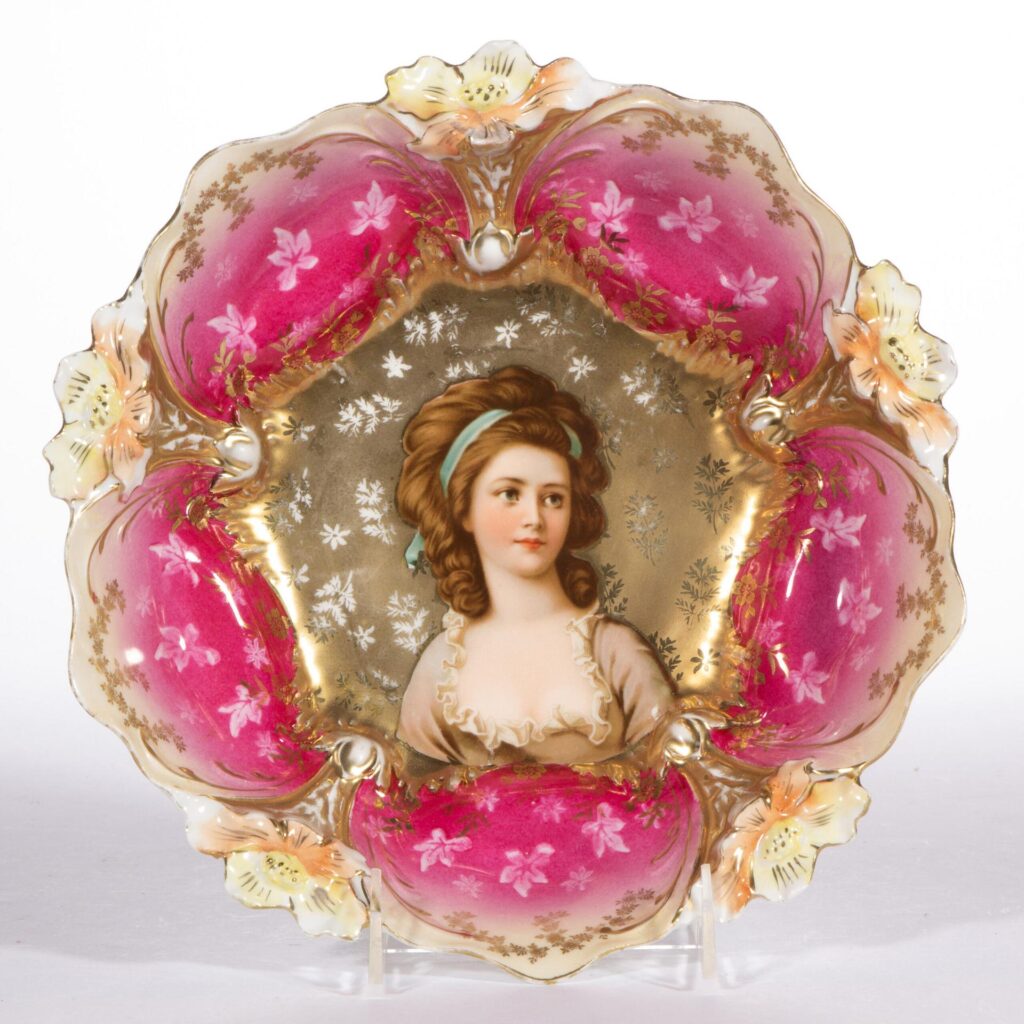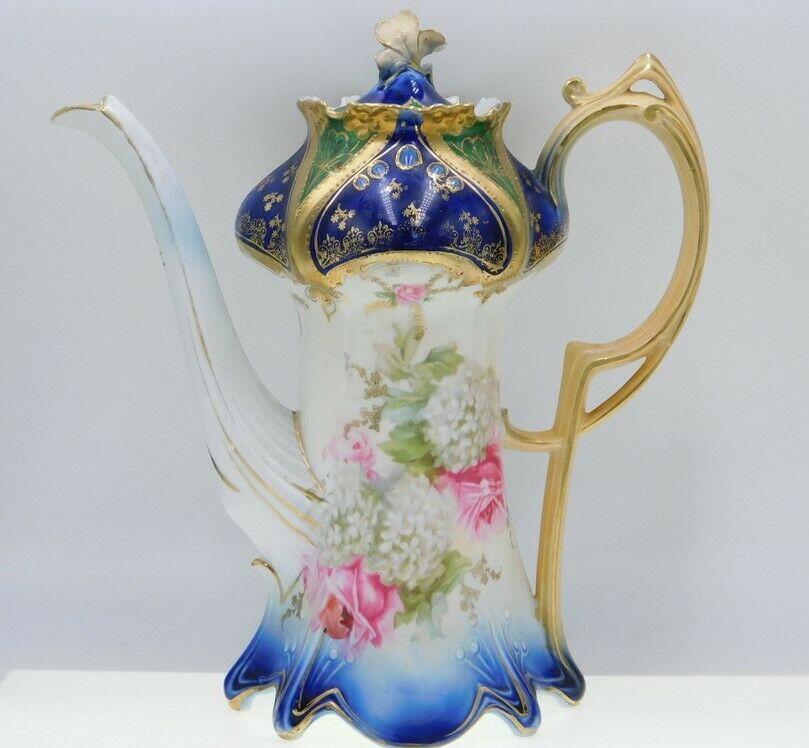#Porcelain #Passion #R.S #Prussia #WorthPoint

Since I started writing about antiques and collectibles back in the late 1990s, no topic has been dearer to my heart than R.S. Prussia porcelain. Yes, it even trumps all my jewelry preoccupations in the sentimentality department. To explain, I have to go back even further in my antiquing history to one of my adventures with my mother.
My mom was an avid collector of many things. She loved using her collectible dishes and glassware. At one point, she had a large collection of vintage and antique dolls, too. But her very favorite thing to collect was R.S. Prussia porcelain. If you’re not familiar with R.S. Prussia, some pieces are marked, but it has distinctive characteristics you learn to recognize by studying each piece you come across.
Over time, you can develop an eye for the unique characteristics of antique ceramics. From the delicate finials that cap lids to the distinctive mold shapes and ornate decorations on chocolate pots, demitasse cups, decorative bowls, and cake plates, it’s possible to identify their origin even if they are unmarked. I absorbed this knowledge from my mom as we shared a penchant for beautiful old things. One particular unmarked piece, in fact, offered my mother and me an opportunity for an antiquing adventure.
The Great R.S. Prussia Bowl Adventure
One Saturday back in the late 1980s, my mother and I ventured out of Houston to our favorite little town, Seabrook, Texas, for lunching and antiquing. After grabbing a bite to eat, we decided to walk around the shops. In one shop that never held much luck before, my mom became coolly enthralled with an unmarked bowl. As I approached to get a closer look, under her breath, she said, “That’s Prussia.” However, it wasn’t bargain-priced, so she sat it down, and we left for home.
As I drove, she literally obsessed over that bowl. She mentioned how beautiful it was and how she knew she’d seen it somewhere. By the time we got back to her house, forty-five minutes away, she couldn’t wait to grab a well-worn book and start flipping through it. Then, there it was, on page 180 of The Collectors Encyclopedia of R.S. Prussia by Mary Frank Gaston, what the author describes as the “Victorian Lay with Dog” bowl valued at $1,000–1,200. As it turns out, the shop’s price of $200 was indeed a bargain, so Mom grabbed her purse, we jumped back in my car, and hightailed it back to Seabrook.
Momma waited excitedly in the car as I walked back into the shop to purchase the bowl. My heart sank as I saw another woman holding it. Luckily, she sat it back down and stepped away, giving me the opportunity to swoop in and pick it up like a fumbled football on the way to the cash register. The lady told me that she was just looking at it, and all I could think to say was, “I know.” The prize was secured, and I could return to the car and make my mom extremely happy.
That bowl sat in a special place in a corner cabinet in her kitchen for quite some time. Several years before she died, she gave it to me to cherish, and I still can’t look at it without thinking about that fun day, all the times we shared antiquing, and all the knowledge I gleaned from her.
More of My R.S. Prussia Favorites
After my mom passed away in 2007, my brother and I split my mom’s R.S. Prussia pieces, and we each took one of her Vernis Martin-style cabinets to keep some of her pride and joy collection on display in our respective homes. I have mine in my home office, so I see it daily and often reminisce about helping my mother grow her collection.
“Helping” includes picking up a set of demitasse cups and saucers decorated with swans that I painstakingly toted back from Connecticut for her. Pieces with animal décor are hard to find and were always among her favorites. They took a back seat, however, to the portrait pieces in her collection. The chocolate pots and plates featuring the likeness of Countess Potocka and Madame Le Brun were her absolute favorites, and in turn, I love them, too. Not only for the portraits but also the beautiful finishes and décor surrounding them.
Now that my brother is gone as well, the rest of my mother’s collection will be coming to reside with me soon. It’s sad to lose those we hold dear, but when their most valued possessions are things we cherish, too, it keeps the spirit of love alive and with us in such a special way. As it turns out, though, some of what Mom thought was true about R.S. Prussia’s origin wasn’t quite on target.

Learning More About R.S. Prussia
That book by Gaston my mom studied so fervently was the collector’s go-to on R.S. Prussia for a very long time. However, thanks to the International Association of R.S. Prussia Collectors, Inc., the history of the company has been updated, and the information is available on the organization’s website.
The fact that people used to believe that brothers Reinhold and Erdmann Schlegelmilch amicably ran the business in Suhl, Germany, together (when they were really competitors operating two separate companies) doesn’t take away from the beauty of this type of porcelain. But now we know that pieces marked R.S. Prussia (along with many unmarked styles) were made solely by Reinhold Schlegelmilch until his sons joined the firm in the early 1890s.
Many of the pieces found today were imported to the United States from the mid-1890s through 1900 or so. By 1905, tastes began to change, and the elaborate molds used in making R.S. Prussia, some of which have art nouveau influences, were no longer in style. Nevertheless, the more elaborate pieces, are indeed what dedicated collectors of this type of porcelain favor, including my mom and me.
Pamela Siegel is a freelance writer and author who has been educating collectors for more than two decades. In addition to three books on topics relating to antiques and collectibles, she frequently shares her expertise through online writing and articles for print-based publications. Pamela is also the co-founder of Costume Jewelry Collectors Int’l (CJCI) and the proprietor of Chic Antiques by Pamela.
WorthPoint—Discover. Value. Preserve.



